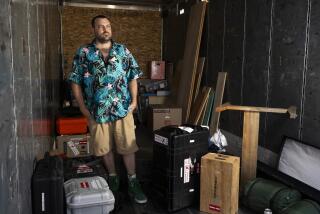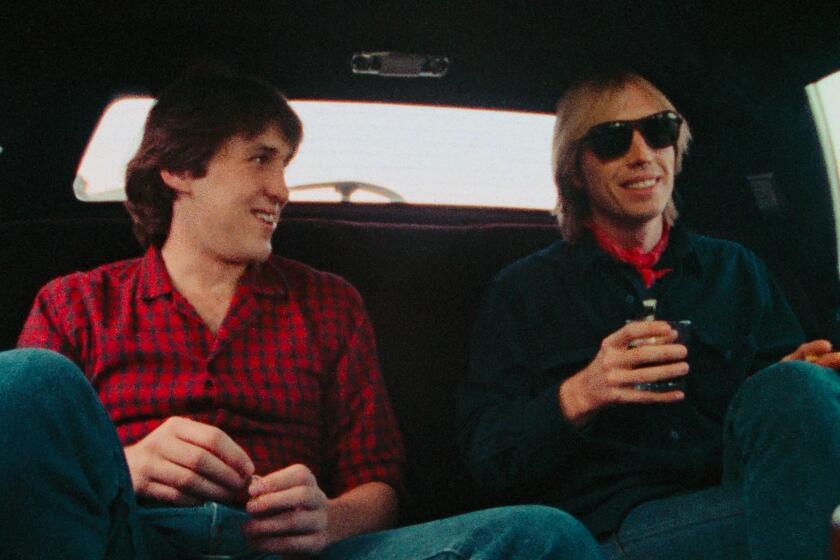Sundance 2014: Zach Braff says Kickstarter led to a better movie

Zach Braff discusses his crowdsourced Sundance film “Wish I was here”
PARK CITY, Utah--Sundance movies can premiere to varying degrees of scrutiny. Few films, though, come in drawing the kind of attention of Zach Braff’s “Wish I Was Here.”
After all, it’s been exactly 10 years since Braff debuted his zeitgeist-defining “Garden State,” with a raucous screening leading to a big sale and one of the quintessential indie movies of the 2000s. Braff hasn’t directed a film since, concentrating on his acting.
Even more pointedly, his new movie, about a 30-something struggling actor and dad who looks for a life reset of sorts, is funded in large part with the help of Kickstarter--about 60% of its $5 million budget comes from a vast network of 47,000 fans. When “Wish I Was Here” world premieres at the festival on Saturday, then, it will become the first-ever showing of a crowdfunded movie made by a well-known Hollywood personality.
In the first interview about the film, Braff explains the strange road getting here, the unique process of making the movie and why he believes this model is far better than the traditional one.
Movies Now: It’s amazing to think it’s been a full decade since “Garden State” became a sensation here. How different does it feel this time around, especially given your increased notoriety and the headlines around this film?
Zach Braff: We were such an underdog back then. We had Natalie Portman, but I was someone who had been on a TV show for a year or two. No one knew about us. We were brand new. There are things I look back at now and love and things that makes me cringe and say, “ugh, first-time filmmaker.” And this is very different. It took me 10 years to make another movie, and because of the success of the first one and the crowdfunding of it all, I’m coming in with a lot more eyes on me. The good news is that no one knows anything about the movie--just that it was partially crowdfunded and Mandy Patinkin and Kate Hudson are in it, and maybe a logline or two--so in that way it actually does feel similar to “Garden State.”
MN: The crowdfunding aspect would seem to fundamentally alter the process in so many ways, not least is that you had thousands of fans who were expecting something along the way. How did that play out?
ZB: Well, the most important thing was to take care of them. I’ve funded a few things on Kickstarter. With some of them I only gave a little money and I got all these updates and felt like part of the process. And then sometimes I’ve given a lot of money and didn’t hear anything. And I wanted to have this be that first, positive experience. I said, “We’re going to break the mold and give people a platinum VIP experience.” We hired three people who could respond to everyone. I didn’t want an email to go a day without a response. It was like running a concierge business.
LIST OF SUNDANCE SELECTIONS: U.S. and World Cinema dramatic competition
MN: That sounds like a pretty extensive undertaking when you’re trying to shoot a film.
ZB: In a normal situation you’re attending to financiers. So instead of worrying about three rich people you have to make sure the needs of a lot of fans are met. It does get a little tricky because you have two giant projects at once--you’re making an independent movie for a budget and also simultaneously running this company. But we wanted everyone to love the experience.
MN: Are there limits? How much could you, say, have fans on set?
ZB: We actually had a lot of set visitors. There are featured extras in the movie from Kickstarter, and there’s one girl who has a line in the film. They were so excited to be there, and we’d set them up at the monitors with earphones and if I had a second I’d come over and explain what we were doing. My brother, who I wrote the film with, had a little more time, so he would talk to them too. Or our producers.
MN: And the crew? Did they feel the same?
ZB: The crew loved having them around because everything’s new to these fans. Those of us on set all the time, there’s nothing’s new about this, but when you have someone who’s from Duluth and a dentist, it’s cool to be able to talk about it and say “Well, this is why we do it this way or why we shoot it like this.” You’d look over and a key grip would be explaining something. It was a lot of fun and never a hassle.
PHOTOS: Winter movie sneaks 2014
MN: The big advantage to doing it this way, of course, is the creative freedom. How much more liberating was it without those three rich people? There’s final cut, of course. What else did it allow you to do exactly?
ZB: This is that rare thing, the director’s dream, where I was the director of the film and also the CEO of the studio making the film. A financier would never have let us stay in L.A., which we did, even though it meant we didn’t get the tax incentive. A financier has a responsibility to shareholders or partners so we would have moved instantaneously to Vancouver or Georgia or someplace like that. And being in L.A. allowed us to make a movie where it’s set, to make it a character in the movie, instead of being somewhere else for all the interiors and then driving by palm trees for a few days and pretending we were in L.A. the whole time. It also allowed us to have this incredible crew because they were just so happy they could stay home and work. We had these great day players, actors who were friends of mine who would come by and help for a day. So all our small roles are outstanding. And that never would have happened if we were financed the traditional way.
MN: Did it allow for big stars too?
ZB: Mandy Patinkin’s schedule with “Homeland” was insane. So we basically had a gentleman’s agreement [with “Homeland” show runners] that allowed him to be here. And a financier would never let it go down that way. They’d call the bonding company and the bonding company say, ‘No way.’ And they’d tell us, “We can’t do this based on a gentleman’s agreement. Recast.”
PHOTOS: Sundance Film Festival 2014 must-see movies
MN: Some would argue that the CEO of the studio making the movie being the same person as the director can be dangerous, that the yin and yang of traditional filmmaking, and the presence of executives, keeps some perhaps more questionable impulses in check. Would you disagree?
ZB: No, not at all. I’m the CEO of the corporation in that the buck stops with me. But we had a lot of voices--Stacey Sher and all our great producers and others who worked on it. There are a lot of other eyes. I was just able to make decisions other filmmakers didn’t have the luxury of making. I was able to listen and say things like, “I hear you, but I think we should do it this way.”
MN: What was the biggest challenge of making a crowdfunded movie?
ZB: It’s the same with every independent movie--time. We’re making a movie in 25 days, and that’s just epic, especially for a film like this, which has fantasy elements and sci-fi elements, and you’re also trying to do a movie in L.A. with a lot of working actors who have very busy schedules.
MN: Do you think all this freedom ups the ante in some way? If people don’t like most films, at least films beyond a microbudget scale, there’s always a studio or an executive or a financier to blame. Kickstarter kind of puts everything on your shoulders.
ZB: Of course, reporters and bloggers and people who follow the business super-closely--they’re thinking about that. But most people who are in the audience will decide if they like it or if they don’t based on the movie. I don’t think they’ll say “That was great--for a crowdfunding movie.” But it’s very interesting for those of us in the business. Ultimately if there’s new and interesting ways to give a creator more freedom, that’s what’s interesting to me. If Spike Jonze or David Fincher, to pick two of my favorites out of a hat, want to make a difficult project with zero compromise, they can do it. Look, for those of us who love the art form, the question is always, “Are there really pure stories we’re missing out on because people are editing to make it work within the model?” The movie that we’ll be showing tomorrow would not nearly be what it was if it had traditional financing. It would be edited differently and have a different cast and made in Vancouver. And that’s a big deal.
ALSO:
Sundance: Highlights include ‘Hellion,’ Finding Fela’
Sundance: Has J.K. Simmons’ created a new Walt White?
Sundance 2014: At ground zero for U.S. films, a Persian spin
More to Read
Only good movies
Get the Indie Focus newsletter, Mark Olsen's weekly guide to the world of cinema.
You may occasionally receive promotional content from the Los Angeles Times.










